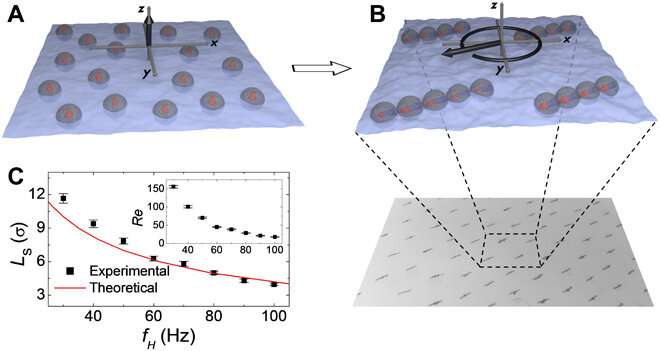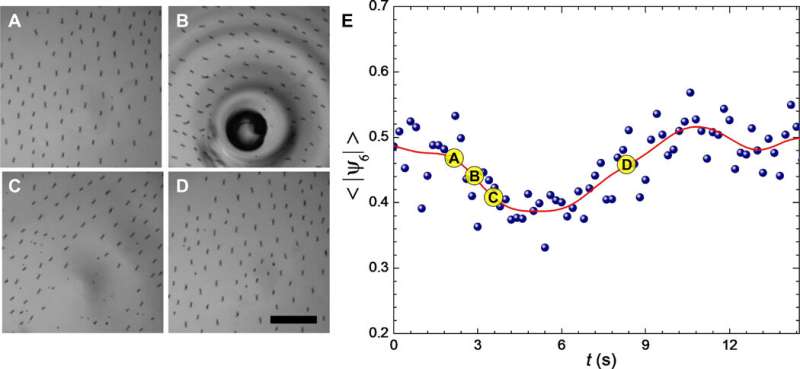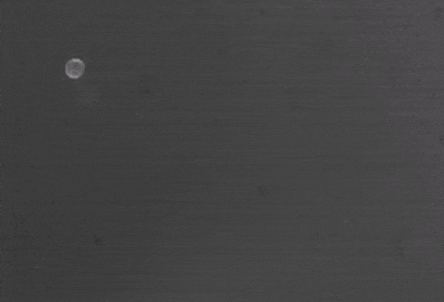March 27, 2020 feature
Reconfigurable structure and tunable transport in synchronized active spinner materials

Thamarasee Jeewandara
contributing writer

Actuated colloids are to investigate emerging out-of-equilibrium structures, complex collective dynamics and design rules for next-generation materials. In a new report, Koohe Han and a research team suspended ferromagnetic microparticles at an air-water interface and energized them with an external rotating magnetic field to form dynamic ensembles of synchronized spinners. Each spinner generated strong hydrodynamic flows with collective interactions between multiple spinners to promote dynamic lattice formation. Using experiments and simulations they revealed structural transitions from liquid to near crystalline states, demonstrating the reconfigurable nature of dynamic spinner lattices. The materials showed self-healing behavior and transported embedded inert cargo particles, tuned by the parameters of external excitation. The findings are now published on Science Advances, and provide insight to the behavior of active spinner materials with reconfigurable structural order and tunable functionalities.
Out-of-equilibrium particles can assign design rules for next-generation reconfigurable materials due to their . Scientists can parameters that are based on an external energy influx from an electric or magnetic field to change the dynamic and collective response of actuated particles in a regulated process . These field-driven active systems are promising candidates for applications in water purification and targeted drug delivery by on demand. Recent research has focused on self-propelled particles ranging from dynamic chaining and clustering to . Exploring dynamic self-assembly of colloidal particles can provide a robust technique to generate large ensembles of . These spinners are not easy building blocks for as they rotate in random directions and disintegrate.
To gain better control and tunability of the active spinner material, the team developed a system of synchronously co-rotating self-assembled spinners that are stable and efficiently coupled through self-induced hydrodynamic flows. In this work, Han et al. reported the dynamic formation of swarms of synchronized and self-assembled spinners from (Ni) particles suspended at an air-water interface and energized with an in-plane rotating magnetic field. The self-assembled spinners generated strong hydrodynamic flows to cause a set of collective dynamic phases. Han et al. combined experiments and simulations to investigate structural and transport properties of these active spinner materials, the findings will provide insight into properties of synthetic active spinner materials for particle transport and manipulation at the microscale.

The team applied a static magnetic field perpendicular to the air-water interface to allow dynamic self-assembly of spinners from suspended ferromagnetic nickel particles. They energized the system using an external rotating magnetic field applied in-plane with the interface. The self-assembly of spinners was fully reversible and controlled via parameters of the external field, to assemble magnetic-field driven multiparticle spinners into nearly lattice-like structures. The magnetic spinners described in the experiments and simulations differed in two important aspects from . Specifically, (1) magnetic attraction between the particles were strong enough to overcome the repulsion and form chains, and (2) the high of spinners allowed the flow field to vary periodically in time.
Han et al. noted large ensembles of the synchronized self-assembled spinners to exhibit dynamic self-organization and calculated the hexagonal bond-oriented order to quantify local ordering of the spinners. Changes in the mean value of the hexagonal bond-order parameters of spinner lattices revealed a clear transition from the liquid phase to the crystalline phases with increasing spinner density. At low density, the spinners retained liquid-like behavior—as the density increased, they became more restricted in their motion to form self-organized spinner lattices.

The simulations similarly captured the liquid-like order of spinners at low densities although their transition to solids were not as pronounced compared to the experiments. To further investigate and characterize the structural order of the dynamic spinner lattices in detail, the team analyzed the relative positions of the spinners within the ensemble and observed the spinners to self-organize into lattices with well-defined frequency-dependent inter-spinner spacing at high densities. The lattices of synchronized spinners formed a new class of active crystals accompanied by a vigorous field. The self-organized spin lattices retained self-healing capacity, which Han et al. showed by intentionally destroying the spinner lattice with a large glass bead passing through its interface—once the bead had passed through the interface, the affected spot self-repaired in a few seconds.

The strong self-induced underlying hydrodynamic flows indicated the possibility for a lattice of synchronized spinners to effectively transport passive cargo particles. To characterize this, the scientists determined the diffusion coefficient for a passive nonmagnetic particle placed inside a dynamic spinner lattice by tracking its (MSD). They referred to particle transport as active diffusion—since the results were orders of magnitude greater than those corresponding to passive thermal . They efficiently tuned the active diffusion coefficient based on the external field frequency. The behavior of the system contributed to changes in spinner-spinner distances within the lattice to form a caging effect on a passive cargo bead and prevent its exit from the cell. Much like with the experiments, the simulations showed enhanced motion and diffusion for small and large tracer particles, however, Han et al. did not observe frequency dependence for the diffusion coefficient during the simulation compared to experiments. The scientists therefore suggest using three-dimensional (3-D) simulations to clarify the origin of the observed discrepancy.

In this way, Koohe Han and colleagues reported the results of structural and transport properties of a new active material composed of self-assembled, synchronized spinners. They suspended ferromagnetic microparticles at an air-water interface for dynamic self-assembly into multiple spinners powered by a rotating magnetic field applied at the interface. The activity of the system originated due to the rotational motion of spinners, unlike conventional active systems composed of self-propelling units. Collective interactions between spinners allowed the formation of new dynamic phases including spinner liquids and self-organized lattices that supported active diffusion through robust, self-generated hydrodynamic flows, alongside self-healing behavior. The team showed the possibility of transporting inert cargo particles within self-organized active spinner lattices with remote control and manipulation. These applications of synchronized spinner swarms will provide new opportunities to design self-assembled structures and tunable transport in active materials at the microscale.
Written for you by our author —this article is the result of careful human work. We rely on readers like you to keep independent science journalism alive. If this reporting matters to you, please consider a (especially monthly). You'll get an ad-free account as a thank-you.
More information: Koohee Han et al. Reconfigurable structure and tunable transport in synchronized active spinner materials, Science Advances (2020).
Alexey Snezhko et al. Magnetic manipulation of self-assembled colloidal asters, Nature Materials (2011).
Bartosz A. Grzybowski et al. Dynamic self-assembly of magnetized, millimetre-sized objects rotating at a liquid–air interface, Nature (2002).
Journal information: Science Advances , Nature Materials , Nature
© 2020 Science X Network
















